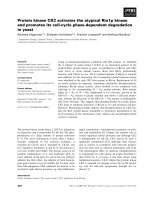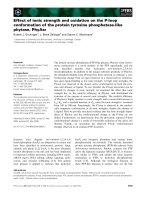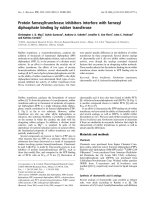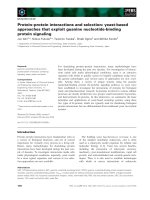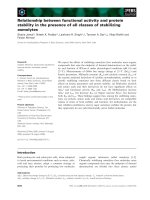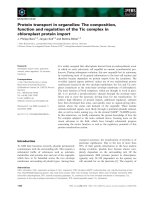Báo cáo khoa học: Protein hyperthermostability – current status and beyond Sotirios Koutsopoulos pdf
Bạn đang xem bản rút gọn của tài liệu. Xem và tải ngay bản đầy đủ của tài liệu tại đây (432.61 KB, 1 trang )
MINIREVIEW SERIES
Protein hyperthermostability – current status and beyond
Sotirios Koutsopoulos
Center for Biomedical Engineering, Massachusetts Institute of Technology, Cambridge, MA, USA
The discovery of hyperthermophilic microorganisms, thriv-
ing at environmental temperatures near or above 100 °C,
has revolutionized our ideas about the upper limit of
temperature at which life can exist. The characterization of
hyperthermostable proteins has broadened our understand-
ing and presented new opportunities for solving one of the
most challenging problems in biophysics: how is structural
stability and biological function retained at high tempera-
tures where ‘normal’ proteins undergo dramatic structural
changes? The general consensus has been that protein hyper-
thermostability does not involve any aberrant features but
rather is accomplished through modifying only the distribu-
tion of structural features (i.e. extended ion pair networks,
increased packing density, decreased number of surface
loops, prevalence of specific amino acids in the sequence,
etc.) that stabilize proteins which are adjusted to other
environmental conditions.
This series contains four articles encompassing different
approaches to, and aspects of, protein hyperthermostability.
In the first article, Matsui and Harata analyze crystallo-
graphic data from homologous mesophilic, thermophilic and
hyperthermophilic proteins and discuss the importance of
buried polar interactions. It has been long suggested that ion
pair interactions are essential to stabilize the protein struc-
ture at high temperatures. Herein, it is proposed that ion
pairs in the core are more important than those on the
surface of hyperthermostable proteins. In the second review,
Luke and colleagues carefully distinguish between hyper-
thermophilic and thermophilic proteins and compare them
with their mesophilic counterparts. Thermodynamic and
kinetic data of protein unfolding in vitro reveal remarkable
differences: the study concludes that hyperthermostability is
primarily linked to very slow protein unfolding kinetics. This
implies that hyperthermophiles survived by selection of
protein mutants that unfold slowly. The third review by
Tehei and Zaccai addresses the role of dynamics on protein
stability. Protein atoms are not fixed, as depicted in crystal
structures, but fluctuate. Hence, the whole protein fluctuates
as well. The dynamic nature of hyperthermostable proteins
may be the key to unraveling the mechanism responsible for
the delicate balance between rigidity, which is related to heat
resistance, and molecular fluctuations at high temperatures,
which account for biological function. In the last article,
Unsworth and colleagues review current theories and suggest
that a combination of structural, dynamic and other physi-
cochemical attributes are optimized to ensure stability and
activity at high temperatures. The potential for utilizing heat
stable proteins was demonstrated in the PCR reaction, a
revolutionary technique in molecular biology. This review
also summarizes methodologies and proposes strategies for
improving heat stability and activity of hyperthermostable
proteins for applications in biocatalysis and biotechnology.
The reviews presented here highlight the significant
advances made to date towards understanding protein sta-
bility and function at high temperatures, but also raise
questions. New discoveries have pushed the limits of hyper-
thermostability to higher temperatures; is it now necessary
to consider as hyperthermostable only those proteins that
are stable at temperatures near 100 °C and above? In aque-
ous media above 100 °C, hydrophobic interactions and
hydrogen bonds are significantly weakened; is this the rea-
son why such interactions are not frequently observed as
stabilizing factors in hyperthermostable proteins? To date,
data have been collected from in vitro studies of dilute pro-
tein solutions; are the conclusions valid for intracellular
proteins where biomolecular crowding is an important sta-
bilizing factor? Structural information for hyperthermosta-
ble proteins is derived from diffraction of crystals grown at
(or below) room temperature; do these crystal structures
represent the structure of these proteins in their native high
temperature environment? Advances in protein science will
continue to generate more systematic structural and physi-
cochemical information on hyperthermostable proteins and
the features that underlie their unique properties.
Sotirios Koutsopoulos is a Senior Research Fellow in the Center for Biomedical Engineering at the Massachu-
setts Institute of Technology (MIT). He received his undergraduate degree in chemistry from the University of
Patras, Greece and completed his PhD in the same institute in physical chemistry of biological phenomena. He
conducted postdoctoral work in the Danish Technical University in nanotechnology and then, as a Marie Curie
fellow, in Wageningen University, the Netherlands, studied biophysics, specifically analyzing factors involved in
the thermal stability and biological function of hyperthermostable proteins. Dr Koutsopoulos joined MIT in 2005
to study protein stability and misfolding in cells.
doi: 10.1111/j.1742-4658.2007.05957.x
FEBS Journal 274 (2007) 4011 ª 2007 The Author Journal compilation ª 2007 FEBS 4011
